Winged battleships
At the end of 1964 in Indochina, a war correspondent for the Stars and Stripes newspaper saw a fabulous night spectacle - a huge plane circled over the battlefield, from whose womb dramatic traces stretched to the ground, illuminating the sky. The spectacle made a strong impression on the journalist, and soon an article appeared in the newspaper entitled “Puff the Fire, Fairytale Dragon”. The sonorous phrase was pleasant to the crew of this aircraft - Puff inscription appeared on board the fuselage, and such aircraft were often called Dragonship. But they are better known to us as Gunship - flying battleships.
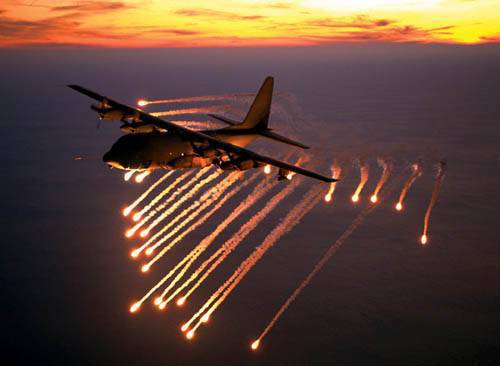
Ships ghana
The concept of the most unusual combat aircraft - "hugs" - was born during the Second World War, although they received the name Gunship (battleship) only during the Vietnamese war. Ironically, the project of a “well-armed aircraft for hitting surface and ground targets poorly protected by air defense weapons” was proposed by Major Paul Gan in 1943; Thus, the “ganship” is not just a “battleship”, but also a “ship of Ghana”. True, the ships of Ghana in the skies over Germany were not destined to appear. It happened in a completely different end of the world.
The Old New Thing
In the 1950-e years, the Americans more and more tightly got into various armed conflicts, primarily in Indochina. And then it turned out that the "traditional" Air Force planes are little adapted for the fight against partisans. Because of their high speed, even in the daytime, fighter-bomber crews struggled to reach small targets that had already been discovered, and at night it was worth forgetting about targeted attacks. In addition, the “jets” were based only on hard-surfaced airfields, of which there were not so many in Southeast Asia. By the time the aircraft was prepared for combat sorties, flight time was considerable, even for a high-speed airplane.
The troops needed a plane with powerful armaments, capable of finding around the clock and effectively hitting targets from the onboard weapons.
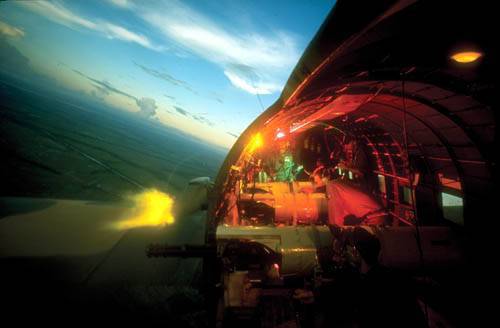
Shooting on turns
Back in 1927, the first US lieutenant, Fred Nelson, fixed a DH.4 machine gun on a biplane at an angle of 900 to the longitudinal axis and performed several successful firing, but the command of the Aviation Corps showed no interest in the experiment. In the 1943, with side arms, Paul Gahn also experimented. At the same time, Lt. Col. MacDonald put forward the idea of arming planes with heavy machine-guns and bazookas firing sideways, and also offered a ready-made method of using these planes for combat — they had to circle around the target at the top of the inverted cone. The base of the cone would serve as the plane of the turn. Guidance on the target was carried out by changing the angle of heel: the barrels of the machine gun were located parallel to the generator of the cone. In this case, the tracks go along the generatrix directly to the top of the cone - to the target. Another advantage of this technique was that the pilot did not lose sight of the goal, visually controlling its defeat.
Go to fight some old people
It was about these works that the Americans remembered. The greatest potential for conversion into attack aircraft had transport aircraft. Their considerable size and payload mass allowed them to place a large amount of weapons and ammunition. In addition, the planes had a significant flight duration, and even then it was assumed that the main type of combat work would be a strike from the “airborne duty” position. The big “truck” was a tasty target for the anti-aircraft gunners, but the anti-aircraft gunners in the partisans of the first half of the 1960's remained in great short supply. The creators of the new type of combat aircraft did not consider the threat from the air defense system at all.
For the Air Force experiments in 1963, the old C-131 was allocated, and the “perpendicular” weapon was installed on it. Despite encouraging results, the idea of an “air battleship” to many of the US Air Force seemed, to put it mildly, exotic. Otherwise, it is difficult to explain the choice of platform for the first combat "ganship": it was a veteran of the Second World DC-3 (aka C-47). Experiment, guys, junk is not a pity.
The plane was named FC-47D (later due to protests by fighter pilots, stung by the fact that the old iron- "Douglas" got into one company with "Phantom", the letter F, Fighter ("fighter"), replaced by A, Attack - “shock”). On the left side of the fuselage perpendicular to the longitudinal axis of the aircraft put the containers SUU-11A / A with six-barreled mini-gun guns. Two machine guns were installed in the portholes of the left side, the third - in the doorway doorway. Tests, or rather, combat missions exceeded the expectations of even the most desperate optimists: it was the work of the first FC-47D that made such an impression on the correspondent of Stars and Stripes.
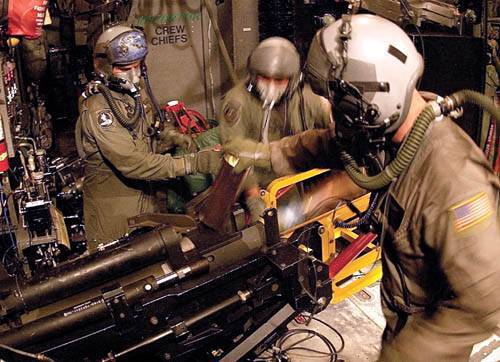
The Path of War
The cloudless military career of the first 15 “ganships” lasted until January 1966, when the squadron was attracted to the blockade of the famous trail Ho Chi Minh, which was guided by partisans from the North. By this time, the NFO units (National Front for the Liberation of South Vietnam) had acquired a large number of 37-mm and 57-mm anti-aircraft guns, including radar-guided ones. In a short time, the Americans lost six AU-47. Another thing - night flights to cover fortified items. Frequently, the “ganship” only needed to find himself once with machine-gun fire, so that the Viet Cong attacks would stop all night. By 1967, the infantry commanders no longer represented the conduct of hostilities in the absence of air battleships - the Air Force did not have time to satisfy the applications. Meanwhile, the conversion to the “ganships” of an additional quantity of C-47 was not possible: the aircraft did not meet the requirements of the Air Force both in terms of carrying capacity and in equipping with special on-board systems. A new platform was required.
On a new platform
The choice fell on the C-119. A large number of these aircraft were in service with reserve squadrons - the US Air Force command still did not believe in the future of the “ganships”. The new "ganship" of the AU-119G Shadow ("Shadow") on weapons did not go far from the AU-47: four mini-ganas instead of three. But they installed a perfect navigation system, a night vision system, a powerful searchlight and an on-board computer, and covered the cockpit with armor. In 1968, the C-119 26 aircraft were converted to the AC-119G version. A year later, the next batch came into service - the 26 machines AC-119K Stinger, which differed significantly from the AC-119G and were specifically designed for night flights over the Ho Chi Minh trail. The onboard equipment was supplemented with navigation radar, moving target detection radar, infrared night vision system, laser range finder and a powerful searchlight. In addition to mini-gans, in the portholes, in special embrasures, they installed two six-barreled Vulcan guns. The result was a qualitatively new aircraft: the onboard equipment allowed it to operate around the clock, and the presence of guns didn’t hit targets without entering the effective range of effective machine-gun fire.
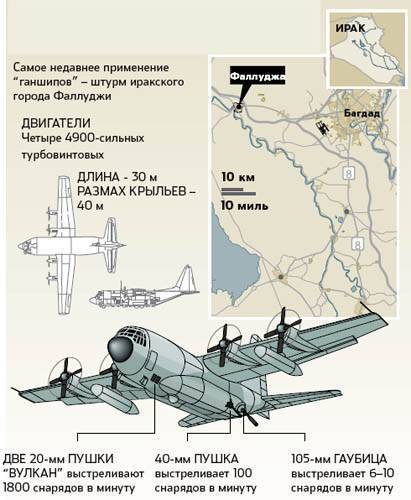
Flying Hercules
The creation of the mighty sky battleship Gunship-2 began in 1965 year. The idea underlying the requirements for the platform did not shine with originality: "The larger the plane, the better." A larger transport aircraft than the C-130 Hercules simply did not exist in the United States. An experienced C-130 gunship was equipped with four MXU-470 mini-gun modules each and four Vulcan cannon guns. The aircraft installed a night-vision system, an analog on-board computer, a radar similar to that installed on the F-20 fighter jets, and powerful searchlights. By September, the 104 of the year managed to bring the aircraft’s equipment to a more or less decent level of reliability and it was transferred to Indochina, to the Nyatrang airbase. The first combat sortie of Vulcan Express - as the first gunship-1967 of its crew called - made on September 2. Before 27 in November, the Spectrum (common name for all AC-9 models) made several sorties to fire support ground troops, while on the night of the 130 the plane passed its main exam in the sky of Indochina over the Ho Chi Minh trail. Almost immediately the operator of the infrared night vision system found six cars on the trail; after 9, six fires burned in their place.
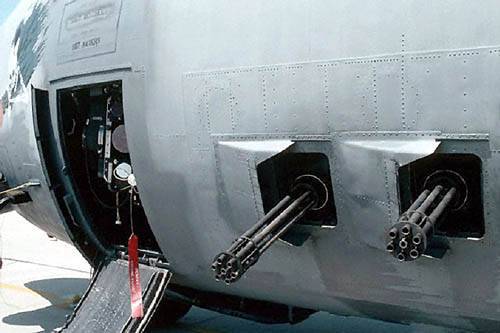
Air fleet
The successful debut of “Spectra” above the path promoted the acceleration of the decision to build new “ganships” based on C-130. The ninth AC-130А served as the basis for the creation of an even more perfect ganship according to the Surprise Package program. Two 20-mm guns were replaced by two 40-mm single-barrel Bofors, dismantled the rear pair of mini gans. The on-board equipment was supplemented with a AN / ASQ-145 television system capable of operating in low light conditions with a laser range finder-aiming indicator; An analog onboard computer was replaced with a digital one. Similarly, nine more C-130 were converted. All airplanes were equipped with the Black Crow system, which intercepted the electromagnetic impulses of the ignition systems of automobile engines, as well as containers with electronic warfare equipment and infrared trap ejection units. These aircraft appeared in Southeast Asia in December 1970, replacing the AU-130A aircraft. The six surviving AC-130A were shipped to the United States for conversion to a single standard, called the Pave Pronto.
Convinced of the high efficiency of the AU-130A, the Air Force headquarters finally allocated for the re-equipment of the 11 completely new C-130E transporters converted into the Pave Specter version. On the new "Hercules" were more powerful engines, increased load capacity allowed the crew to install armor protection and improve working conditions. The first AC-130E landed in Thailand at Ubon airbase at the end of 1971.
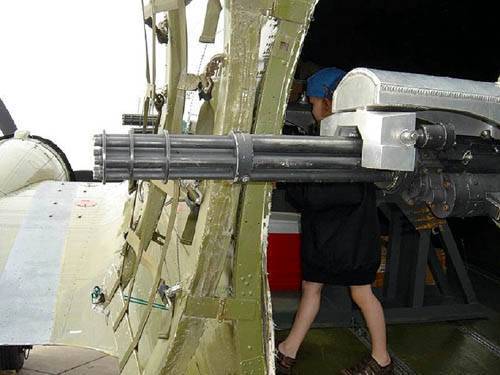
Ship Artillery
40 mm caliber guns effectively hit cars, but not Tanks. Meanwhile, the T-34-85, T-54/55, and PT-76 tanks began to be transferred to the south along the Ho Chi Minh trail in ever-increasing quantities, and the strengthening of air defense continued. It was possible to avoid losses only by firing at targets from a great distance, outside the area of anti-aircraft fire. Specialists from the Wright-Patterson Air Base have proposed several options for enhancing the firepower of the AC-130, the option of arming a 105-mm army howitzer was recognized as the best. Unprecedented in stories aviation A “trunk” was mounted instead of one “Bofors” in the cargo door of the port side. The howitzer fire control system was in many respects similar to the fire control systems of the main caliber towers of large ships. AC-130E Pave Specter aircraft with 105-mm howitzers began combat work in 1972.
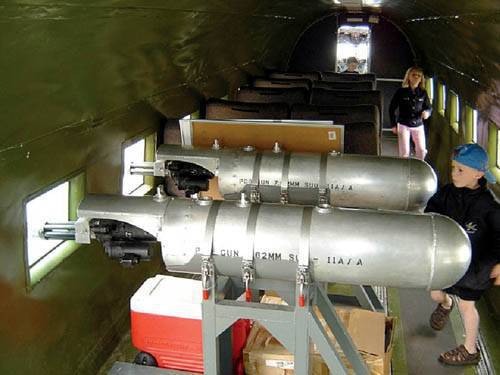
Deadly threat
The first Soviet C-75 anti-aircraft missile system in the Ho Chi Minh trail area, US intelligence detected 11 on January 1972. Against the new anti-aircraft missiles "Hercules" was defenseless. However, the replacement of the AC-130 was not. Despite the danger, the Spectra continued to iron the roads, turning them into death corridors. From January to March, their crews destroyed the 2782 vehicle, damaging another 4553. The retribution came in March 31: AC-130E, armed with an 105-mm cannon, was hit by radar-guided anti-aircraft guns. Two days later, the C-75 SAM missile sent another AC-130 to the ground, but the crew did not escape. The loss of two expensive aircraft in two days resulted in almost complete cessation of AC-130 flights over areas where the concentration of air defenses was particularly large.
In the defense of An Lok, the North Vietnamese used a new formidable weapon - the Strela portable anti-aircraft missile system. 12 May 1972, one AC-130A got hit by a rocket launched from the shoulder; the crew managed to reach Tan Son Nate air base. After a short time, the Arrows shot down two more AU-130. Despite the loss, the Spectra flew combat missions until the inglorious end of the war.
Second birth
In 1986, the US Air Force Command approved a program for the modernization of special-purpose aircraft, including nine AC-130. Modernization has undergone primarily airborne electronic equipment of aircraft. And in 1990, a new version of the ganship, the AU-130U, featuring a more advanced internal filling and a five-barreled 25-mm GAU-12U automatic gun, which was installed instead of two 20-mm “Volcanoes”, drove onto the runway of the factory airfield in Palmdale.
For the first time since Vietnam, AU-130 took part in hostilities during the invasion of Grenada. Operation Argent Fury (“Furious Rage”) began on the evening of October 24 1983. The planes took off from the Harlbert Field airbase and, after making an 10 hourly night flight with two refueling stations in the air, in the morning of October 25 appeared over the capital Grenada, Port Salinas. The AU-130H provided fire support for the landing of troops and suppressed several small-caliber anti-aircraft artillery batteries with fire from their guns.
During the Gulf War in January-February 1991, four AU-130Hs from the 4 Squadron made 50 sorties, flying more than 280 hours. The main task of the "gunships" was to search for and destroy Scud ballistic missile launchers, as well as radar for the early detection of aerial targets. The planes could not perform any of these tasks. The search equipment AC-130H did not work in the hot desert atmosphere, saturated with dust and sand. In the 1990's, the ganships were noted in Somalia, in the Balkans, currently operating in Afghanistan and Iraq.
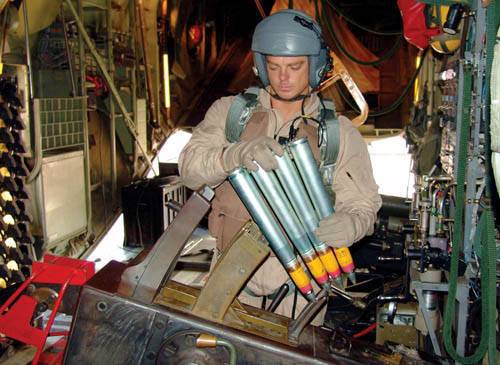
Chechen option
From the point of view of combat effectiveness, “Ganship” is an ambiguous aircraft. The history of “winged battleships” testifies to their inability to act in the face of serious air defense counteractions, but as a counterguerrilla aircraft, the “ganship” has no equal. Now the "counter-guerrilla" aircraft have become "anti-terrorist." As part of the buildup of antiterrorist forces, Boeing received an order for $ 2004 million at the start of 187,9, contemplating upgrading four C-130H2 transport airplanes into the AC-130U ganship with the latest guided missiles and adjustable bombs. Unlike their sea brothers, the battleships, the air battleships are still too early to landfill.
Information